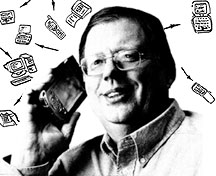Dedication
Introduction
Dan Ariely
Walter Bender
Steve Benton
Bruce Blumberg
V. Michael Bove, Jr.
Cynthia Breazeal
Ike Chuang
Chris Csikszentmihályi
Glorianna Davenport
Judith Donath
Neil Gershenfeld
Hiroshi Ishii
Joe Jacobson
Andy Lippman
Tod Machover
John Maeda
Scott Manalis
Marvin Minsky
William J. Mitchell
Seymour Papert
Joe Paradiso
Sandy Pentland
Rosalind Picard
Mitchel Resnick
Deb Roy
Chris Schmandt
Ted Selker
Barry Vercoe
Chris Schmandt
I like to build things that show new ways of communicating, and to create synthetic auditory experiences not available in the real world. Speech is about human communication.
When connectivity becomes ubiquitous, how might we use it to stay in touch with all the people we care about? I envision communication channels that are always on but not always transmitting, with characteristics that vary as activity around me changes, and that are aware that my participation also affects those around me. How can we harmonize the immediate environment in which we are situated with the remote parties at the other end of a channel? And how can we communicate richly and expressively, aware of the message and not the constraints imposed by the transmission technology?
 Our family, social, and work lives are increasingly fragmented and face-time is dear. As it becomes harder to be physically co-present, technology that enables virtual presence may help us hold things together. Mobile phones are great for talk but are noisy, consume our attention, and are in many ways too purposeful. Wireless PDAs are more programmable and text more manageable, but they are often awkward. I want to find sweet spots of new communication methods that cause us to re-think connectivity, with user interfaces as comfortable as well-worn clothes.
Our family, social, and work lives are increasingly fragmented and face-time is dear. As it becomes harder to be physically co-present, technology that enables virtual presence may help us hold things together. Mobile phones are great for talk but are noisy, consume our attention, and are in many ways too purposeful. Wireless PDAs are more programmable and text more manageable, but they are often awkward. I want to find sweet spots of new communication methods that cause us to re-think connectivity, with user interfaces as comfortable as well-worn clothes.
Yes, it's about speech, but not exclusively. Awareness channels may convey someone's activity or mood through low bit rate, always-on connections with ambient displays. Consider the baby monitor that chirps my phone every time the child cries, or the watch that glows when my spouse is alone in her office, or the lamp that shines when my parents are awake, inviting a conversation. The awareness may itself be the message or the goal, causing a sense of contact, or it may be the portal to richer synchronous communication at an appropriate time.
Shuffling time and place may be facilitated by audio technology that more accurately reflects or takes cues from human conversational behavior, such as the answering machine that segments its recording and presents in question/response format. We don't know if this works yet; we do know that if done poorly, it easily annoys. We also have to understand how people's conventions and expectations change; collectively we are much more effective at leaving voice messages than we were a few decades ago, and have adapted rapidly to mobile phones.
But it's also about fun, about entertainment, about using our ears and sense of hearing to do many things at once. Our hearing is not so challenged by the real world; we can create synthetic listening experiences that convey information more densely and rapidly, with the price of requiring greater attention. When might we use these? Can it help our failing memories to record everything?
At the Media Lab we can invent new technologies, but I want these to be situated in real communication needs. By building prototypes, we can start to explore new combinations; by telling stories around them perhaps we can influence others. I want our visitors to imagine themselves using our inventions to stay connected to their own families and friends.
First computer: I hauled shopping carts of punch cards to whatever IBM mainframe was in the MIT Computing Center in 1971.